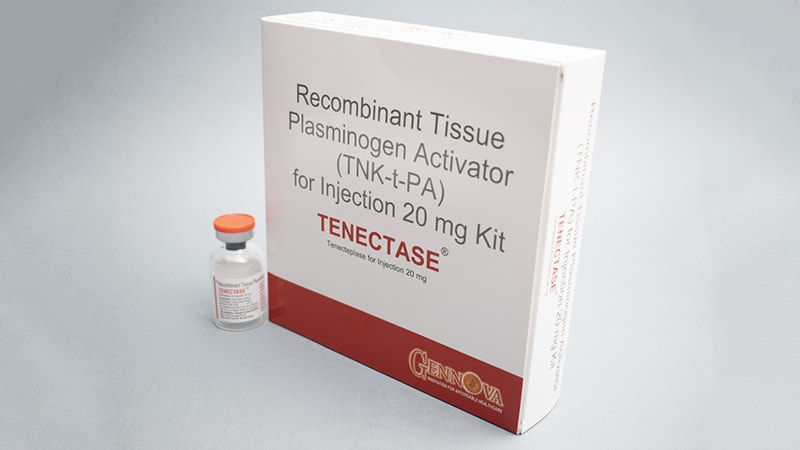LUTS Associated With Poorer Cognition in Older Adults LUTS Associated With Poorer Cognition in Older Adults
May 17, 2024Crossing State Lines: PA Licensure Compact Coming Soon Crossing State Lines: PA Licensure Compact Coming Soon
May 17, 2024
The bolus thrombolytic agent, tenecteplase, narrowly failed to show non-inferiority to alteplase in the TASTE clinical trial within 4.5 hours of symptom onset selected by perfusion imaging in patients with acute ischemic stroke.
However, the trial was stopped early after previous studies had shown the non-inferiority of tenecteplase to alteplase, thus reducing its power. In addition, the per-protocol analysis did meet non-inferiority criteria.
An updated meta-analysis of all the studies comparing the two thrombolytics, including these latest TASTE results, has demonstrated for the first time that tenecteplase is superior to alteplase for excellent recovery (modified Rankin Scale [mRS], score 0-1) 3 months after stroke.
The TASTE trial and the updated meta-analysis were presented on May 15 at the European Stroke Organization Conference (ESOC) 2024 annual meeting.
Case Closed
“The TASTE trial is the only phase 3 trial of tenecteplase that has used advanced perfusion imaging to select stroke patients, which gives a precise identification of ischemic stroke and excludes patients who may have conditions that mimic stroke,” study investigator Mark Parsons, MD, University of New South Wales, Sydney, Australia, told Medscape Medical News.
Our results therefore add reassurance that with the additional information provided by perfusion imaging showing we are treating the correct patients, we still see non-inferiority of tenecteplase with alteplase.
“It therefore lends considerable weight to the previous evidence showing non-inferiority of tenecteplase to alteplase, with the updated meta-analysis now suggesting superiority,” he added.
Parsons said the study results “pretty much close the chapter of tenecteplase versus alteplase in the early treatment window for thrombolysis in ischemic stroke (within 4.5 h of symptom onset). There is currently a worldwide shortage of tenecteplase, but once that is resolved, then I think most hospitals will switch from alteplase to tenecteplase.”
The TASTE was a multicenter, randomized, controlled phase 3 non-inferiority trial conducted in 35 hospitals in eight countries. Patients were randomized to receive intravenous tenecteplase (0.25 mg/kg) or alteplase (0.90 mg/kg).
The primary outcome was the proportion of patients without disability (mRS, 0-1) at 3 months. Safety outcomes were all-cause mortality and symptomatic intracranial hemorrhage.
The trial was stopped early after 680 of the planned 830 patients had been enrolled following the results of previous tenecteplase trials. In the intention-to-treat analysis, the primary outcome occurred in a numerically higher proportion of patients allocated to tenecteplase (57.0%) than those allocated to alteplase (55.3%). This translated into a standardized risk difference of 0.03, which narrowly missed the predefined non-inferiority criteria of a lower boundary of −0.03.
In the per-protocol analysis, non-inferiority was demonstrated, and safety outcomes were comparable between groups.
Faster Time to Treatment
The updated meta-analysis of all the tenecteplase vs alteplase studies showed a significant absolute benefit of 4% in favor of alteplase in the number of patients achieving a full recovery (mRS, 0-1), Parsons reported. This was achieved in 59% of tenecteplase patients vs 55% of alteplase patients.
“This translates into a number needed to treat of 25. For every 25 patients treated with tenecteplase versus alteplase, one additional patient will achieve full recovery. That’s pretty powerful on a population level,” he said.
He pointed out that as tenecteplase is administered via a single bolus injection, it is easier and quicker to administer than alteplase, which is given as a bolus plus an infusion, thus saving time in the urgent treatment of patients with acute stroke.
“In a previous study where thrombolysis was given in a mobile stroke unit, giving tenecteplase saved 7 minutes compared to giving alteplase. So, if we ever get to the stage of routinely treating in the ambulance, then bolus tenecteplase will really make a difference,” he added.
Commenting on the study results, Carlos Molina, MD, Vall d’Hebron Barcelona University Hospital, Barcelona, Spain, noted that tenectaplase is easier to administer, which should accelerate the time to treatment.
“These new results and the updated meta-analysis give us new evidence that will accelerate the transition to tenecteplase when the worldwide shortage resolves.”
The TASTE trial was funded mainly by the National Health and Medical Research Council of Australia. Some additional funding and the study drug were provided by Boehringer Ingelheim. Parsons is on a Boehringer advisory board.
